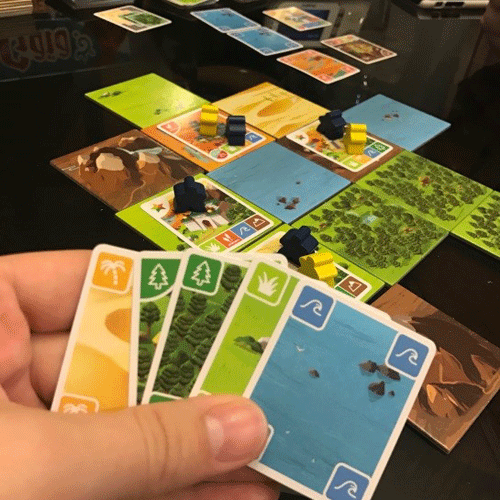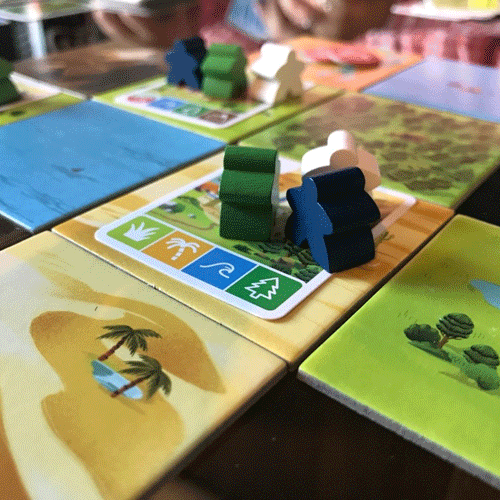Gaia (2nd Edition) Review
on Dec 1, 2016
In the beginning there was nothing. The entire universe was a vast expanse of emptiness. And then 2-5 gamers got a hold of some colorful tiles and assembled the world and all the cities in it. Eventually they got bored and started tearing down those cities with lightning and earthquakes. And they smiled and it was good.
Gaia is a remarkably simple game that manages to construct an engaging experience as easily as you construct the patchwork board. The goal of the game is get rid of all your meeples by placing them into cities you or your opponents have built. Cities must be built on land tiles and so turn by turn players will build a little world out of brightly colored tiles both together and against each other.
See, cities have 4 needs - or at least the people inside them do. Some want to be near a source of food while others might want beautiful seaside vistas. Players can lay down a city card on any tile assuming that at least two needs are met by tiles adjacent to the new city. This is extremely important, as laying down a city effectively eliminates a tile’s type and may anger neighboring meeples who abandon if their minimum needs aren’t met.

The future world at your finger tips
This comes together in something that feels a bit like Suburbia Lite. Tiles influence their neighbors and chains can be built or broken based on what you play. You may have placed a city after fulfilling two of its needs, but I can send a meeple to join you if I can manage to fulfill a third or fourth. Early games will see plenty of cohabitation. Once players have built and torn down enough worlds, the game gets a bit more competitive as you wait to build a city until all four sides of your target tile are full. Since no one can increase the number of met needs, they’re effectively locked out in the base game.
The joy of Gaia comes from these simple tactical decisions. There’s certainly a risk to waiting until a tile is surrounded; anyone else can play a city there first and lock it up themselves. When that happens there is a mad scramble to get in on the city while you can so that you don’t fall too far behind. You only have 5 meeples to place between cities and public objectives so it doesn’t take much to jump ahead or fall behind. This is especially true using only the basic rules as it’s much harder for meeples to come off the board. With advanced rules, you can manipulate the world in creative ways. With basic rules you’re either hoping an adjacent space runs out of food or that you can build another city over one of the tiles that provides the original city’s needs.

All 4 needs of this city are met by the adjacent tiles. Happy meeples.
As you add rules, Gaia’s clean simplicity falls away at the same rate that the game’s tactical decisions go up. It’s necessary to strike a balance here. With the full 5 players, I can’t imagine playing a game with access to all of the advanced powers like Earthquakes that swap tiles or Lightning Bolts capable of destroying cities and all the meeples on them. On the other hand, playing a two player game with no advanced rules is pretty bland. At the very least you should include powers like Rain – it converts deserts to plains to swamps.
These rules really elevate the game from a casual and friendly affair to something that can be brutally cutthroat. They have to be added carefully however. Gaia’s fragile core can only handle so many powers and abilities before it crumbles in on itself. The game loses any semblance of planning with too many powers flying around. Gone is careful intelligent design, in its place are the fickle gods of Greek mythology hurling tornados at each other and re-sculpting the world out of spite and malice. Gaia allows you to craft the game you want to play as much as you craft the world in the game. Groups that want a lighter experience can play with the basic rules and find a clever tile-layer I’m happy to keep on my shelf. Gamers looking for more can wield the elements and inject a little chaos. Gateway weight games have a place in every gamer’s collection and this is one I would recommend to almost everyone. The bright and colorful tiles of Gaia build a world you’ll want to come back to over and over.

 Customer Support
Customer Support  Subscribe
Subscribe 




 Account
Account  Wishlist
Wishlist 
